おすすめの Google 拡張機能です!新しい言葉を勉強しましょう!
Here are the recommended Chrome extensions! Let’s learn new words here!
 えみ先生
えみ先生もう 2月になりました。
時間が過ぎるのは、早いですね。
みなさん、日本語の勉強は どうですか?
がんばっていますか?それとも、1月は たくさん休みましたか?
今日は、アイスブレイクとして 日本の2月のイベントについて 話します。
「節分」というイベントです。
【えいご】English Translation
It’s already February.
Time passes quickly, doesn’t it?
How is everyone’s Japanese study going?
Are you working hard? Or did you take a lot of breaks in January?
Today, as an icebreaker, I will talk about a Japanese event in February.
It is an event called “Setsubun.”
| ことば|Words | 読みかた|How to read | 意味|Meaning |
| 行事 | ぎょうじ | event |
| 立春 | りっしゅん | a day Spring starts |
| 鬼払い | おにばらい | exorcism |
| 追い払う | おいはらう | to drive away |
| 豆 | まめ | bean |
| (豆を)まく | (まめを)まく | to throw, to sprinkle |
| 生命力 | せいめいりょく | a life force |
| 正しい | ただしい | correct |
| 典型的 | てんけいてき | typical |
| 炒る | いる | to roast |
| 神棚 | かみだな | a Shinto household alter |
| お供え(する) | おそなえ(する) | to make an offering |
| 迷惑(な) | めいわく(な) | annoying, troublesome |
| 無駄にする | むだにする | to waste |
| 厄除け | やくよけ | warding off bad luck |
| 掛け声 | かけごえ | a chant, a shout |
| 特に | とくに | especially |
| 縁 | えん | fate, bond |
| 向く | むく | to face towards |
| 丸ごと | まるごと | the whole amount |
| 方角 | ほうがく | direction |
| 実際 | じっさい | actual |
節分って なに?|What is Setsubun?
節分は、2月の行事です。
毎年、日にちが変わります。2025年は2月2日が節分です。
まずはじめに、漢字をチェックしてみましょう。
「節」は、季節の「節」、「分」は「分ける」という意味です。
節分は「季節が変わる日」という意味があります。
2月は、「立春」という「春になる日」があります。その前の日が節分の日です。
季節が変わる時は、鬼が出ると言われています。
だから、節分の日には「鬼払い」(=厄払い)をするんです。
そして、病気や災害などの悪いものを追い払って、いい1年にするために、「節分」という行事が始まりました。
病気や災害などの悪いものがないことを、「無病息災」と言います。
【えいご】English Translation
Setsubun is a February event.
The date changes every year. In 2025, Setsubun will be on February 2nd.
First, let’s check the kanji.
The “節 (setsu)” in Setsubun means “season,” and “分 (bun)” means “to divide.”
Setsubun means “the day when the season changes.”
In February, there is a day called “Risshun,” which marks the beginning of spring. The day before that is Setsubun.
When the seasons change, it is said that demons (oni) appear.
Therefore, on Setsubun, people perform “oni-barai” (driving away demons = warding off evil).
To drive away bad things like illness and disasters and to have a good year, the tradition of Setsubun started.
💡 The state of being free from illness and disasters is called “Mubyou Sokusai.”
節分の文化|Culture of Setsubun
豆まき|Mamemaki the Bean-Throwing

季節が変わる「節分」には、鬼が出ます。
その鬼を追い払うために、鬼に豆を投げる「豆まき」が始まりました。

どうして豆なんですか?
 えみ先生
えみ先生いい質問ですね!
日本では、豆は「生命力 (生きる力)」があって、「悪いものを追い払う力」があると言われていました。
そのため、鬼を追い払うために 豆をまくようになりました。
【えいご】English Translation
On Setsubun, when the seasons change, demons appear.
To drive away these demons, people throw beans at them. This is called “Mamemaki.”
[Student👤] Why beans?
[Emi-sensei👩🏫] Good question!
In Japan, beans were believed to have “life energy” (the power to live) and the power to “drive away evil.”
For this reason, people started throwing beans to drive away demons.
正しい豆まきの方法|The Correct Way for the Bean-Throwing
豆まきには、やり方があります。地域によって違いますが、典型的なルールをチェックしてみましょう!
- 節分の前日に、豆を炒って、神棚にお供えします。この豆を「福豆」と言います。
神棚が場合は、白い紙の上に福豆をのせて、高いところに置いてもいいです。- 豆を炒る=魔目(鬼の目)を射る という意味があります。
- 節分の日の夜、家族みんなで豆まきをします。本当は、鬼は真夜中の2時〜5時に来ますから、夜がいいです。
ですが、夜は迷惑になりますから、夕方にします。- 家の中から外に向かって、「鬼は外」と言いながら豆をまく
- 家の外から内側に向かって、「福は内」と言いながら豆をまく
- 豆まきが終わったら、投げた豆は片付けます。
豆は食べものなので、無駄にしないように、殻付きの豆(落花生など)を投げたり、豆の代わりに 小さく丸めた紙を投げる人もいます。 - 豆まきのあとは、1年の厄除けを願って、自分の年+1の豆を食べます。これを「年取り豆」と言います。
【えいご】English Translation
Mamemaki has a specific way to do it. The method varies by region, but let’s check the typical rules!
- On the day before Setsubun, roast beans and offer them at the household shrine. These beans are called “fukumame.”
If you do not have a household shrine, you can place the fukumame on a white piece of paper and put it in a high place.- Roasting beans has the meaning of “shooting the demon’s eyes” (魔目 / mame).
- On the night of Setsubun, the whole family does Mamemaki.
In reality, demons come between 2:00 AM and 5:00 AM, so night is best.
However, since it would be a nuisance, people do it in the evening.- Throw beans outside the house while saying, “Oni wa soto!” (Demons out!)
- Then, throw beans inside the house while saying, “Fuku wa uchi!” (Fortune in!)
- After finishing mamemaki, clean up the thrown beans.
Since beans are food, to avoid waste, some people use shelled peanuts or throw small balls of paper instead. - After mamemaki, eat the number of beans equal to your age +1 to wish for protection from evil throughout the year. This is called “Toshitori Mame.”
豆まきの掛け声|A Shout for the Bean-Throwing
「鬼は外、福は内」が典型的な掛け声です。
地域によって、違う掛け声があります。
好きな地域があれば、掛け声があるか調べてみてください。
【えいご】English Translation
The typical chant for mamemaki is “Oni wa soto! Fuku wa uchi!“
Different regions have different chants.
If you have a favorite region, check what chant they use!
| 地域|Region | 掛け声|A Shout | 意味|Meaning |
|---|---|---|
| 全国的 *Nationwide | 鬼は外、福は内 | Demons Out, Fortunes In! |
| 宮城県 仙台市 | 福は内 福は内、鬼は外 鬼は外、天打ち地打ち四方打ち、鬼の目ん玉ぶっつぶせ | Fortunes In x2, Demons Out x2, Shoot it to the sky, Beat it to the ground, Hit it all over, and blind the demon’s eyes. |
| 群馬県 藤岡市鬼石 Onishi, Fujioka-shi, Gunma | 福は内、鬼は内 | Fortunes In, Demons In. |
| 京都府 福知山市 Fukuchiyama-shi, Kyoto | 鬼は内、福は外 | Demons In, Fortunes Out. |

いろんな「かけ声」があって、おもしろいですね!
 えみ先生
えみ先生おなじイベントでも、たくさん文化があるんです。
群馬の藤岡市では、悪い鬼だけではなく、いい鬼もいると信じられているので、「鬼も内」です。
そして、京都の福知山市では、まず鬼を迎えて(「鬼は内」)、いい鬼になったら外に出す(「福は外」)という意味があるそうです。
【えいご】English Translation
[Student👤] There are many chants, and it’s interesting!
[Emi-sensei👩🏫] Even for the same event, there are many different cultural aspects.
In Fujioka City, Gunma, people believe there are not only bad demons but also good demons, so they say “Oni mo uchi!” (Demons in too!).
In Fukuchiyama City, Kyoto, people first welcome the demons (“Oni wa uchi!“), and once they become good demons, they send them out (“Fuku wa soto!“).
豆まきの歌|Songs for Bean-Throwing
豆まきの歌もあります!
特に、「鬼のパンツ」はとても有名な童謡(子どもの歌)です。
聞いてみましょう。
【えいご】English Translation
There are also some songs for Mamemaki!
Especially, “Oni no Pants” is a very famous children’s song.
Let’s listen to it!
節分の食べ物|Food for Setsubun
節分の日に食べる、有名な食べ物があります。
どんな食べ物かチェックして、みんなで節分の日に食べましょう!
【えいご】English Translation
There are famous foods eaten on Setsubun.
Let’s check what they are and eat them on Setsubun!
恵方巻き|Ehomaki: A Long Lucky Sushi Roll
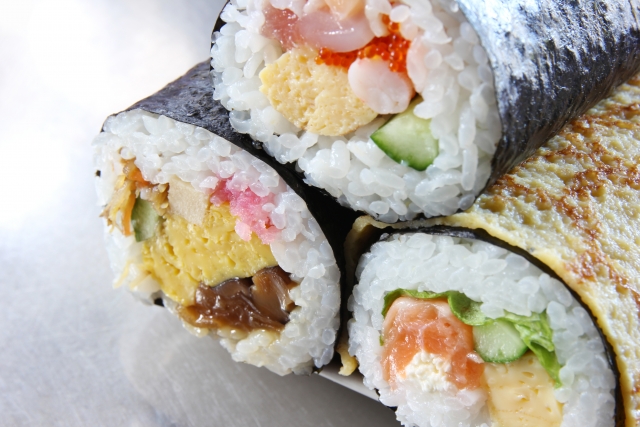
恵方巻きは、節分の日に食べる巻き寿司です。
そして、恵方巻きを食べるときは、その年の良い方角「恵方」を向いて食べます。
2025年の恵方は、「西南西」です!
他にも、恵方巻きを食べるときのルールがあります。
【えいご】English Translation
Ehomaki is a rolled sushi eaten on Setsubun.
When eating Ehomaki, you must face the year’s lucky direction, “Eho.”
The lucky direction for 2025 is “West-Southwest!”
There are also rules when eating Ehomaki.
恵方巻きを食べるときのルール
- 恵方巻きを食べるとき、包丁で切ってはいけません。🔪❌
恵方巻きを切ることは、縁を切るということです。切らずに、そのまま食べます。 - 食べるときは、その年の「恵方(いい方角)」を 向いて食べましょう。
- 食べているとき、話してはいけません。食べているときに話すと、縁や福が 逃げます。
願い事をしながら 食べますが、食べている間は 一言も話さないようにしましょう。
この3つのルールを 守ると、いいことが あるかもしれませんね。
今年の恵方(いい方角)が分からない人は、アプリでチェックしてみてください。
【えいご】English Translation
Rules for Eating Ehomaki
- Do not cut Ehomaki with a knife. 🔪❌
Cutting it means “cutting off luck.” - Face the year’s “Eho” (lucky direction) while eating.
- Do not talk while eating. Talking while eating makes your luck escape.
- Make a wish while eating, but do not say a single word until you finish.
If you follow these three rules, something good may happen!
If you don’t know the lucky direction for this year, check it with an app!
けんちん汁|Kenchin-Jiru

私は食べたことはありませんが、関東地域(東京、神奈川、千葉など)では、節分の日に「けんちん汁」というスープを飲みます。
「けんちん汁」は、大根や豆腐、しいたけなどの食材が入ったスープです。
けんちん汁を飲むと暖かくなりますし、節分の日は寒いですから、節分の食べ物として有名になりました。
【えいご】English Translation
I have never eaten it, but in the Kanto region (Tokyo, Kanagawa, Chiba, etc.), people have a soup called “Kenchin-jiru” on Setsubun.
Kenchin-jiru is a soup with ingredients like daikon radish, tofu, and shiitake mushrooms.
Having Kenchin-jiru warms you up, and since Setsubun (season) is cold, it became a famous Setsubun food.
クイズ|Quiz
節分についてのクイズです。
よくブログ記事を読んで、クイズに答えましょう!
何問 正解できますか?
もう一度、読みますか?
【えいご】English Translation
Here is a quiz about Setsubun.
Read the blog carefully and answer the quiz!
How many can you get right?
Do you want to read it again?
❓節分は、どの季節の前ですか?|Before which season is Setsubun?
「立春」という春になる日の前に、「節分」の行事があります。
「節分」には、「季節を分ける」という意味があります。
It is held the day before “Risshun,” which marks the beginning of spring.
“Setsubun” means “dividing the seasons.”
❓ 鬼を追い払うためのイベントの名前はなんですか?|What is the name of the event for driving demons away?
「豆まき」です。ほとんどの地域では、「鬼は外、福は内」と言って 豆まきをします。
It is “Mamemaki: Bean-Throwing.” We do Mamemaki doing a shout “Demons out, fortunes in.”
❓ 節分の食べ物は、どんなものがありますか?|What food do we have for Setsubun?
「恵方巻き」という巻き寿司や、「けんちん汁」という野菜がたくさん入ったスープがあります。
We have a sushi roll called “Ehomaki“ and soup with a lot of vegetables called “Kenchin-jiru.”
❓ 今年の恵方(いい方角)はどこですか?|Which direction is Eho (a good direction) of this year?
2025年の恵方は、「西南西」です!
The lucky direction for 2025 is “West-Southwest!”
節分の動画|YouTube Videos for Setsubun
YouTubeの動画を見て、実際の節分がどんな感じかチェックしてみましょう!
【えいご】English Translation
Watch these YouTube videos to see what Setsubun is like!
まとめ|Summary
節分について、みなさんは知っていましたか?
みなさんは どんな節分を過ごしますか?
ぜひ恵方巻きを食べて、豆まきをしてみてくださいね。
【えいご】English Translation
Did all of you know about Setsubun?
How will you spend your day on Setsubun?
Be sure to try Ehomaki and Mamemaki!
じゃあ、またね〜!👋
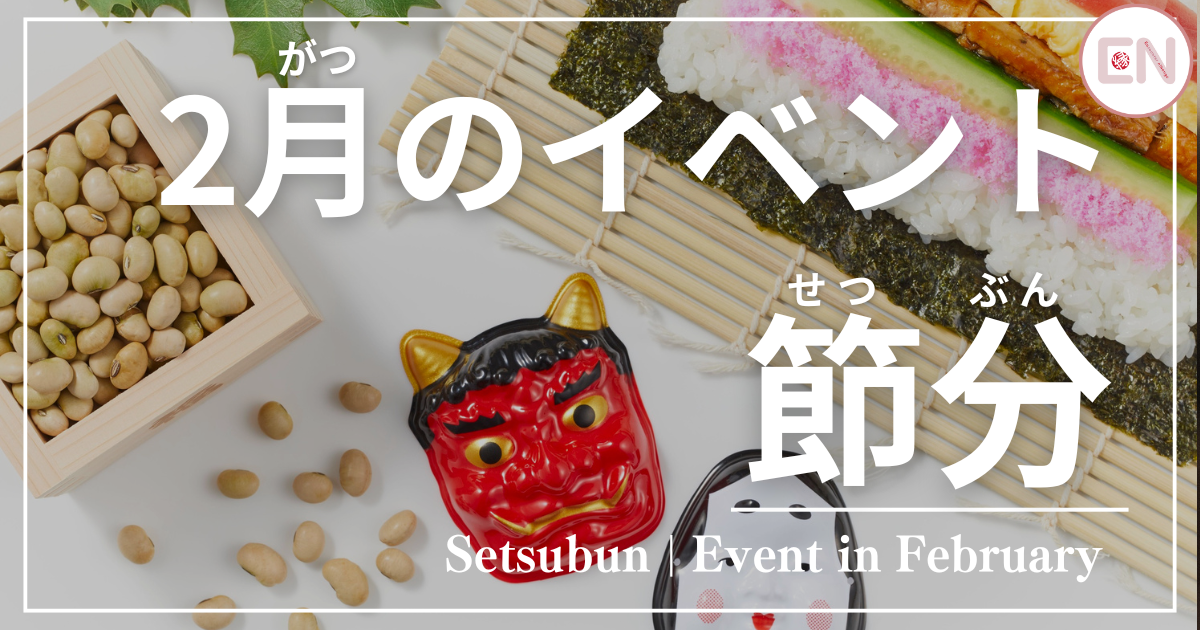
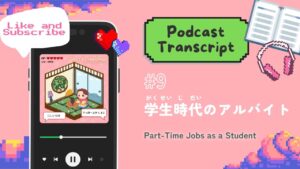
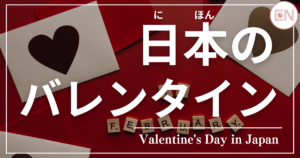
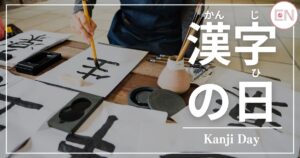
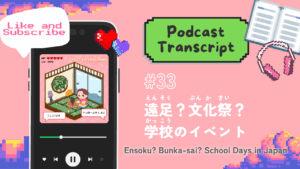
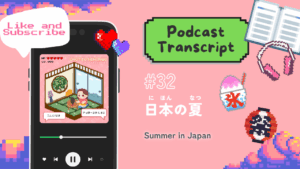
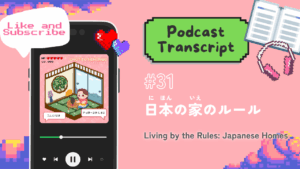
コメント|Comment